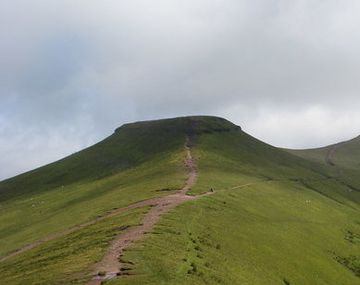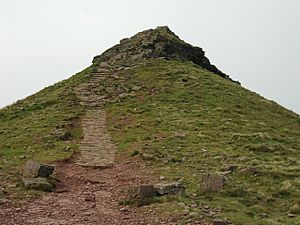Corn Du facts for kids
Quick facts for kids Corn Du |
|
|---|---|

The summit of Corn Du
|
|
| Highest point | |
| Elevation | 871.5 m (2,859 ft) |
| Prominence | 28.2 m (93 ft) |
| Parent peak | Pen y Fan |
| Listing | Nuttall |
| Naming | |
| English translation | black horn |
| Language of name | Welsh |
| Geography | |
| Location | Powys, Wales |
| Parent range | Brecon Beacons |
| OS grid | SO012215 |
| Topo map | OS Landranger 160 |
Corn Du is an amazing mountain peak in South Wales. It's the second highest peak in the area, standing tall at 871.5 meters (about 2,864 feet). You can find it in the beautiful Brecon Beacons National Park.
Corn Du is like a twin to Pen y Fan, which is the highest peak. It's only about 550 meters away from Pen y Fan and just 13 meters shorter. At the top of Corn Du, there's an ancient stone pile called a cairn. This cairn was built during the Bronze Age and likely holds a special burial spot, similar to one on Pen y Fan. Both Corn Du and Pen y Fan are so tall that you can see them from far away. They are famous landmarks in the Welsh landscape. From their summits, you get incredible, wide-open views of the surrounding mountains and valleys.
Contents
Exploring Corn Du: Paths and Views
Corn Du is a popular spot for hikers. Many people cross its summit when they are walking to Pen y Fan. It's part of a well-known walking route through the Brecon Beacons.
Amazing Scenery from the Top
From Corn Du, you can look down into a valley called Cwm Llwch. You can also see across the River Usk valley all the way to the town of Brecon. To the east, you might even spot the Sugar Loaf, Monmouthshire mountain near Abergavenny.
Tommy Jones' Obelisk
On the western side of Corn Du, you'll find Tommy Jones' Obelisk. An obelisk is a tall, narrow stone pillar, often built to remember someone or something important. This one stands between Corn Du and another peak called Y Gyrn.
Walking on the Moorland
The land around Corn Du is mostly open moorland, which means you can explore many parts of it. However, some areas can be tricky to cross, like peat bogs (wet, spongy ground). The main walking paths are well-built and looked after by the National Trust, making your hike easier and safer.
Corn Du's Rocky Secrets
The top of Corn Du looks a lot like Pen y Fan's summit. It's flat and shaped a bit like an anvil. This shape comes from the type of rock it's made of.
Strong Ancient Rocks
Corn Du is formed from very strong, erosion-resistant sandstones. These rocks are from the Devonian period, which was millions of years ago. They are part of what geologists call the Upper Old Red Sandstone, specifically the "Plateau Beds." These rocks are tough and don't wear away easily.
Visible Rock Layers
You can clearly see layers of these rocks, called rock strata, at the edge of the mountain. They form a strong, cliff-like edge. These same rock layers are visible all along the northern face of the mountain range. They also appear in the Black Mountain (range) to the west. There, they cap the tops of peaks like Picws Du and Fan Foel, forming steep cliffs below them.
Glacial Lakes: Nature's Ponds
Near Corn Du, you'll find one of the few natural lakes in the Brecon Beacons National Park. It's a small lake called Llyn Cwm Llwch.
How Glaciers Created Lakes
This lake, along with bigger ones like Llyn y Fan Fach and Llyn y Fan Fawr in the Black Mountain (range) area, was formed by glaciers. During the last ice age, huge sheets of ice moved across the land. As they moved, they scraped out hollows in the ground below the peaks.
Moraines and Water
The water in these lakes is partly held in by piles of rock and dirt called moraines. These moraines were carried down by the ice as it moved. The ice also broke off pieces of rock through processes like plucking and frost shattering. These natural processes helped create the beautiful glacial lakes we see today.
Images for kids




